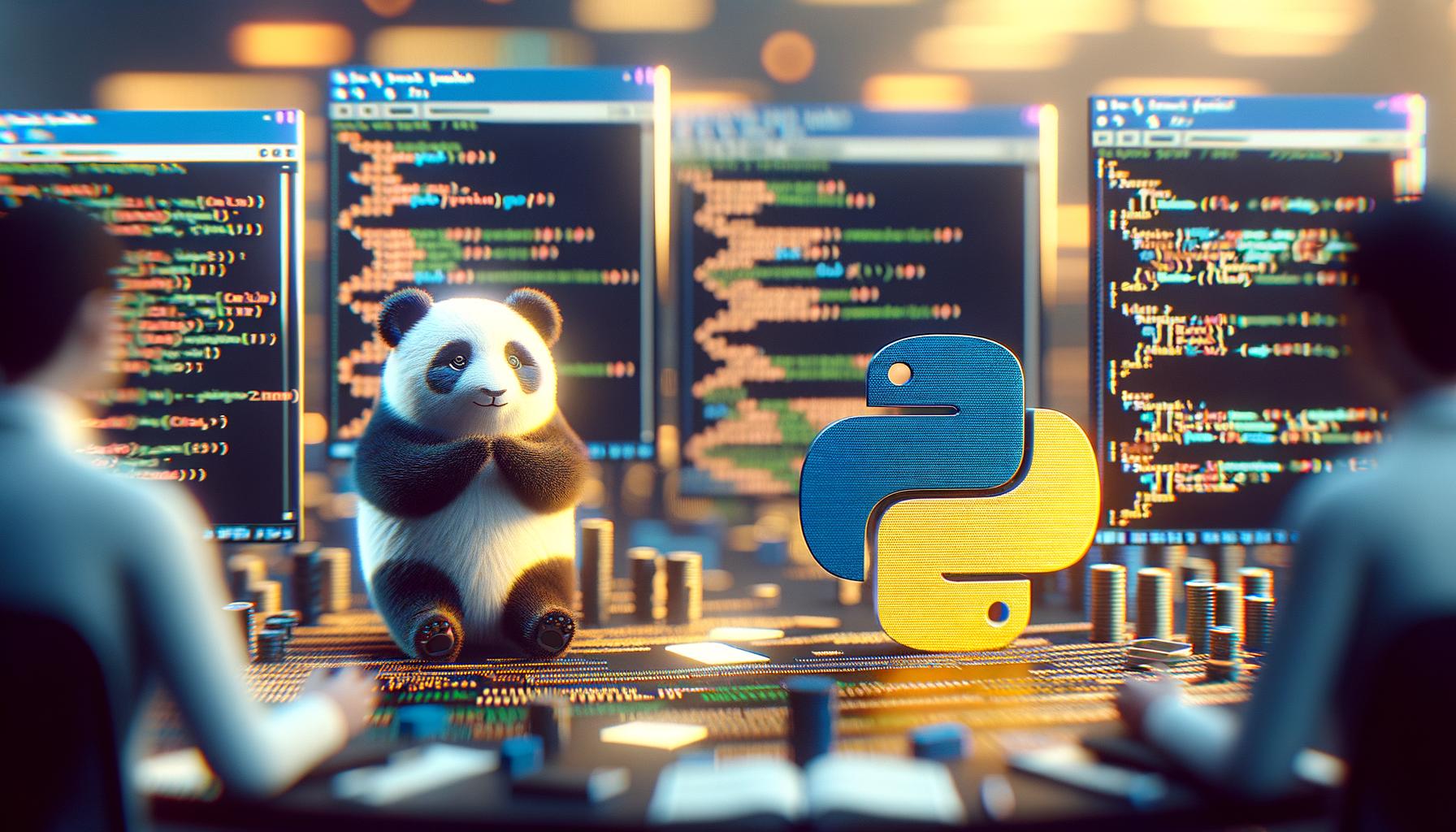Mastering the Art of Python in Data Science

In the ever-evolving world of Data Science, mastering Python has become indispensable. As a language known for its widespread use, Python significantly contributes to data science operations all-around the globe. The reasons for its ubiquity stem from the impressive array of features it brings to the table and the robust community of developers who support it. Understanding Python opens doors to a deeper understanding of syntax, variable application, decision making, loops, and a diverse range of data types – opening the pathway for mastery in key aspects of data science. Moving forward, delve into the core fundamentals of the Python language, its standard library, developer tools, and the functionalities for data manipulation. Lastly, societal shifts towards data-driven decision-making underscore the necessity of proficiencies like web scraping, big data handling, and practical project applications in Python. Therefore, embarking on this journey to master Python will surely strengthen and accelerate your data science career.
The Role of Python in the Data Science World

Python's ubiquity across diverse disciplines is a testament to its flexibility as a programming language, but it also has a uniquely vital role in data science. Not only is it an accessible entry-level language for those new to programming, its array of libraries and frameworks greatly simplify complex tasks unique to this field, allowing data scientists to more efficiently clean, process, analyze, and visualize data. Moreover, the continuous evolution of these tools in line with the needs of the data science community means Python remains a relevant and forward-looking resource. The array of applications of Python in data science are varied and far-reaching, such as automating data collection through web scraping, utilizing machine learning algorithms, overseeing big data solutions, and so much more.
Key to Python's integral role in the data science world is the support offered by its expansive community. This collective resource is fundamental in providing a continuous flow of updates, debugging solutions, and enhancements that address the evolving needs of data science professionals. From community-sourced Python packages specifically designed for data science, to the open-source nature allowing constant refinement of the language itself, being part of the Python community brings an enormous advantage. This sense of community not only allows for the sharing of knowledge and resources but also helps to foster innovation, as issues that arise can be addressed collectively, allowing for efficient problem-solving backed by an array of professional experiences.
Getting Started with Python: Basic Concepts

Dipping your toes into the world of Python, it's crucial to grasp some fundamental concepts to smoothen the journey ahead. Python's syntax, to begin with, bears an uncanny resemblance to the English language, which makes it a desirable option for beginners to data science. It is intuitive and avoids complex rules that usually accompany other programming languages. Its simplicity allows users to focus more on problem-solving rather than getting entangled in the technical details of the syntax.
Next up, understanding the application of variables becomes crucial in scripting your Python code. Variables serve several purposes in a Python script— they store data, facilitate data manipulation, and assist in decision-making processes. As an illustration, in a data science context, a variable might hold a data set, or a specific data type to analyze. Speaking of decision-making loops, these aspects drive the mechanics of your script and manage the organizational flow. For example, condition-based 'if-else' decisions alter the path of a script’s execution based on certain conditions, while 'for' or 'while' loops repeat certain actions, a vital feature for data iteration and analysis.
Moving on to data types, Python houses several, such as numeric, string, and list data types, each playing a unique role. A numeric data type, like integers or floats, is ideal for computational tasks while strings help store and manipulate textual data. Lists, on the other hand, are containers to store multiple data types together. Furthermore, Python also possesses other versatile data types like dictionaries, Boolean, tuples, sets, and range data types. These expansive options equip Python with an incredibly flexible data handling capability, honing its desirability in the data science community.
Understanding Data Types in Python
Understanding data types is pivotal when using Python for data science. Three primary types of data that Python recognizes are numeric, string, and list data types. Numeric data type in Python includes integers, floating point numbers, and complex numbers, which forms the base for statistical computation. String data type is used for text data manipulation such as data cleaning and preprocessing. Lists, on the other hand, are ordered sequences of items, which can be of different data types. This versatility of list data types has broad applications, especially when dealing with complex datasets.
Two additional data types vital in Python are dictionary and Boolean. Dictionaries in Python are an unordered collection of data values which are used to store data values like a map. They can increase the efficiency of data manipulation tasks. Boolean data type, comprising of two values- True and False, are key to control flow statements and are a cornerstone for programming logic in Python.
Furthermore, Python also recognizes tuple, set, and range data types. A tuple is a sequence of immutable Python objects, and they are used when the data cannot change. Sets, on the other hand, are an unordered collection of unique elements; they are fantastic tools to eliminate duplicate values. The range data type represents a sequence of numbers and is used in for loops and to generate numerical sequences.
In summary, understanding these data types in Python is critical when implementing data science projects. By correctly applying these data types, one can efficiently perform data manipulation and computation to drive valuable data insights.
Mastering the Python Language Fundamentals

Mastering the fundamentals of the Python language is vital in the journey of Python for data science. One of the core components of these fundamentals is understanding functions and packages. Functions are reusable pieces of programs. Using them not only increases code readability but also reduces redundancy and errors. Packages, on the other hand, are a collection of modules, functions, and classes providing additional functionality to Python.
Taking our programming abilities to the next level requires knowing the essence of modularity. Modules break down large programs into small manageable and organized files. Each module can be tested separately, ultimately minimizing the chance of error in the overall program.
Python is known for striking a balance between utility and simplicity of its programming language. An example of this balance is the Python Standard Library, which provides an exceptional array of modules and tools that extend the base functionalities of Python. This package enables effective data handling and rapid program development all without the need for external libraries.
Moreover, error handling and exceptions are fundamental to writing a reliable and robust Python program. Using try and except blocks, you can catch and respond to errors that might arise during the execution of your program. It gives control back to your code and allows your program to be less prone to crashing.
Another crucial part of mastering Python fundamentals is familiarizing yourself with Python Developer Tools. Understanding these tools will not only aid in producing high-quality code but will also streamline testing and debugging processes—making your code more effective and efficient in the world of data science.
Data Manipulation with Python

When it comes to data manipulation in Python, the focus primarily centers on maintaining data quality and mastering the basics of data cleaning. Ensuring high-quality data is crucial as this is the foundation on which the entire analysis rests. Misleading or inaccurate data can result in a skewed analysis and incorrect conclusions. Therefore, Python tools such as pandas and NumPy arrays are commonly used for data cleaning and transformation, providing features that ensure the integrity and quality of data. Sound knowledge of these tools, coupled with a good understanding of the types of errors that could occur in the data, aids in the efficient cleaning and preparation of data for analysis.
Python Libraries for Data Science lend their support towards effective data manipulation; these include NumPy, pandas, Matplotlib, Sci-Kit Learn, Tensorflow, Keras, and Beautiful Soup, among others. The selection of a library depends on the specific needs of the task at hand - for example, NumPy’s advanced mathematical capabilities are particularly suitable for large and complex calculations, while pandas is exceptionally powerful for data manipulation tasks. Being versatile and adaptable are key parts of mastering Python for Data Science, and this includes becoming familiar with the multitude of libraries available and understanding when to use each tool.
Introduction to Python Libraries for Data Science

Building one's expertise in data science essentially requires familiarity with Python libraries, each serving unique functionalities. For instance, there's Numpy, a powerful tool for mathematical computing that simplifies dealing with Numpy arrays and facilitates in-depth comprehension about functions, operations and Dtype Objects. It's important to select the right tool for specific tasks, which ultimately boosts efficiency. Pandas is another effective resource that eases data wrangling and analysis, offering robust data structures and wrangling capabilities. When it comes to data visualization, libraries like Matplotlib and Seaborn take precedence. Lastly, Sci-kit Learn, Tensorflow, and Keras are instrumental for machine learning and deep learning applications. Therefore, learning about these libraries and using them properly significantly aids in data science operations.
Numpy: Powerful Tool for Mathematical Computing

Numpy, or Numerical Python, stands as a vital tool in the realm of mathematical computing within data science. Known for its power-packed array object, Numpy provides a robust framework for big data analytics. These multidimensional arrays, a cornerstone of the Numpy library, allows data scientists to perform a multitude of functions, execute operations, and manipulate Dtype objects seamlessly. Its convenience and efficiency in handling large datasets make it indispensable in high-level mathematical functions and complex operations.
As an example, statistician Dr. James Jones, credited Numpy's superior mathematical capability in transforming a significant portion of his raw data into analyzable formats promptly. “With Numpy's prowess in mathematical computing, computations like standard deviation, mean, median etc., can be done in a breeze.” he notes. Consequently, understanding and utilizing Numpy allows for faster and higher quality data analysis, making it an irreplaceable asset in any data scientist's toolkit.
Pandas: Data Wrangling and Analysis Made Easy

In the realm of data science, Pandas is an indispensable tool that excels in data wrangling and analysis. It brings to the table robust data structures that simplify managing data. For instance, Pandas' DataFrame structure facilitates handling and manipulation of heterogeneously-typed data, much like a SQL table or an Excel spreadsheet.
Also, Pandas empowers data scientists to perform complex data wrangling tasks with precision and ease. From merging and reshaping data to filtering unwanted information, and pivoting tables for a better data perspective, these operations are seemingly effortless using Pandas. Reality-check examples of this include cleaning LinkedIn profile datasets, where it was necessary to prune irrelevant data, or financial data analysis, where merging different sources into a concise table was key.
In terms of analysis, Pandas provides efficient tools for deciphering data trends and patterns which would otherwise stay hidden in unprocessed data. For example, the eBay web transaction data analysis shed light on customer behavior trends, critical for enhancing business strategies. These examples substantiate how mastering Pandas amplifies one's ability to harness data, a vital skill in data science.
Matplotlib and Seaborn: Visualizing Data with Python

Data visualization is a core component of data analysis. Using Python libraries, such as Matplotlib and Seaborn, this process is more streamlined. Matplotlib allows for the creation of static, animated, and interactive visualizations in Python, making data interpretation user-friendly. On the other hand, Seaborn, based on Matplotlib, provides a high-level interface for drawing attractive and informative statistical graphics.
Applications of these libraries are vast. For instance, a simple line graph using Matplotlib can illustrate trends over time, while Seaborn's 'Violin plot' can show the distribution, median, and interquartile range of a dataset simultaneously.
Interestingly, the pivot towards these Python-based libraries is due to their ability to integrate excellently with other libraries like Numpy and Pandas. Their fine-tuned compatibility ensures smooth data visualization, making them a handy tool for data scientists.
In conclusion, mastering Matplotlib and Seaborn is crucial in transforming raw, often complex data into digestible information. By leveraging these python libraries, data scientists can effectively communicate findings to stakeholders thereby guiding well-informed decision-making.
Sci-Kit Learn: Towards Machine Learning

The journey into machine learning with Python would be incomplete without Scikit-learn. Known for its simplicity and efficiency, Scikit-learn is an indispensable tool in implementing machine learning algorithms. It breaks down complex procedures into manageable concepts, making the learning process intuitive and practical.
This kit particularly excels in supervised learning, where it helps in processing labeled data and making accurate predictions. For instance, applying Scikit-learn to a dataset of house prices would enable the model to predict future values based on existing data.
Moreover, the kit's prowess in unsupervised learning, where there's no input-output mapping, is noteworthy. Instead, Scikit-learn is used to discover hidden patterns or structures from unlabeled data, such as grouping customers into different categories based on buying behavior.
Indeed, Scikit-learn proves to be a robust and versatile tool, capable of meeting diverse machine learning needs. With its potent algorithms and user-friendly interface, it holds a significant role in Python's data science suite.
Lastly, one simply cannot overlook the kit's continuous evolution in line with industry's advancements and requirements, which makes it an all-rounded package for all machine learning endeavors.
Tensorflow and Keras: Introduction to Deep Learning

Deep learning can be accessed through the computational framework of Tensorflow and the simplicity of Keras. Tensorflow enables unparalleled computational power to execute complex tasks, while Keras streamlines your deep learning process, making it accessible for beginners. From image recognition to natural language processing, practical applications of such deep learning tools are expansive and constantly growing. Harnessing these tools will equip you to leverage Python’s potential in your data science journey.
Python in Data Collection: Web Scraping Techniques

Python plays a critical role in the age of information, serving as a powerful tool for web scraping in data collection. A basic understanding of this technique unlocks valuable data not typically available through APIs. To do this efficiently, mastering the applications of Beautiful Soup and Scrapy is essential. These libraries provide an efficient path to accessing and parsing HTML code, facilitating the extraction of substantial data from the web. Using these tools, Python scripts can gather vast amounts of structured data from various web resources, an essential aspect of data science applications.
Handling Big Data with Python
Indeed, handling large data sets is a key component of Python use in data science. This becomes essential due to the increasingly massive data generated in today's digitized world. Python aids in scaling and controlling these vast data repositories by providing certain libraries tailored for efficient big data handling. For instance, PySpark and Dask offer specific capabilities designed with big data challenges in mind.
Moreover, with Python's ability to interface with high-performance, distributed computing frameworks like Apache Hadoop, data scientists can effectively manipulate and analyze large datasets. These libraries and interfaces provide an edge to Python, enabling parallel computing and out-of-memory computations, largely reducing data handling time and complexity.
Therefore, Python's versatility combined with the power of these libraries offers an efficient, scalable solution to big data challenges. The implications of these tools are broad and vital, illustrating Python's robust handling of big data in real-life data science projects.
Applying Python in Practical Data Science Projects

Applying Python practically in data science projects commences with prudent project selection. Identify a project that could be substantially enhanced by incorporating Python's vast capabilities. For example, consider a market segmentation task. Being able to segment your customers using Python’s machine learning libraries can lead to more targeted marketing strategies. Furthermore, Python's versatility grants it a wide range of application in various projects, the boundaries of which are determined only by your creativity and understanding of the language. As an illustration, Python can be a potent tool for a project involving sentiment analysis, where it can mine text data from social media and predict user sentiments regarding a certain product or brand. Python doesn't just streamline processes and improve outcomes; it can potentially redefine the objectives and scopes of your projects. Lastly, by exposing your hands-on Python experience in such projects, you are adding value to your data science career. Proficiency in Python isn’t just a skill; it’s a seal of your analytical prowess, and as such, it could potentially escalate your standing in the data science community.
Boosting Your Data Science Career with Python
Python proficiency holds immense value in the data science job market. It's a crucial skill sought after by employers. Python's extensive capabilities, from data cleaning to visualization, make it an integral tool for any data scientist's arsenal. Staying updated on Python's role in data science is imperative. Developers regularly roll out new libraries and tools, and data scientists must keep up with these advancements to leverage Python's full potential.
A wealth of resources is available for continued education in Python. Platforms including Coursera and Codecademy offer comprehensive Python courses. Books like "Python for Data Analysis" and "Python Machine Learning" provide in-depth knowledge. Joining online communities like StackOverflow or GitHub also offers invaluable learning opportunities.
An understanding of Python’s vast array of libraries and tools is crucial, which serves different needs in data science projects, including computations, graphic representations, data analyses, machine learning, and deep learning. Always choose the tool that best fits the task at hand.
Interestingly, Python’s constant evolution ensures its relevance and strength in the competitive realm of data science. Career advancement for data science professionals is accelerated by mastering Python, thereby staying competitive.
Given Python’s significant role, mastering it equates to a solid foundation for a thriving data science career. Its versatility makes it a preferred choice for data scientists worldwide. Python mastery can truly boost your data science career.
Keeping Up-to-date: Python's Constant Evolution in Data Science

Staying abreast with Python's continuous development in the realm of data science is pivotal. Python's constant evolution ensures optimization and introduction of innovative features. For instance, recent updates such as Walrus Operator in Python 3.8, have further simplified data handling and analysis tasks, underscoring the essence of staying informed and adaptable. Hence, Python practitioners should make consistent learning a habit to leverage the full potential of this versatile language in data science.
Conclusion: The Journey Towards Mastering Python in Data Science

In conclusion, mastering Python is critical for anyone aspiring to have a successful career in Data Science. This article helped to reinforce that notion, by providing a comprehensive guide on the fundamental concepts and powerful tools of Python that are relevant in Data Science. Always remember, the journey of becoming proficient in Python for Data Science is one of constant growth and adaptation, thus, keeping abreast with the language's evolutionary advancements is advantageous. At the same time, being aware of the real-world applications of Python in diverse projects significantly enhances your employability in this dynamic field.
